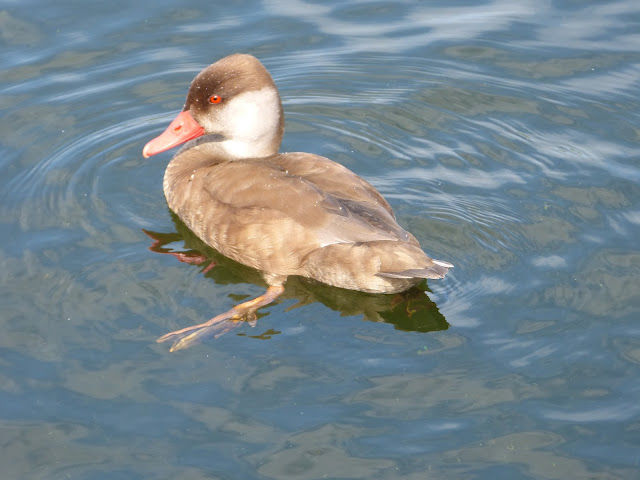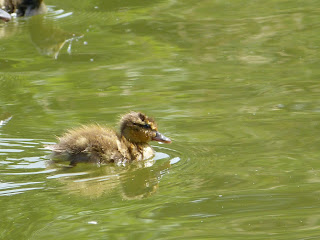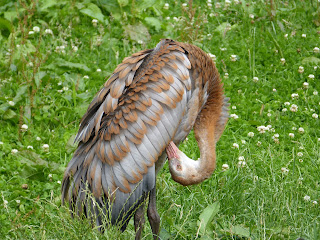I couldn't think of a collective noun for all of the different species of bird that visited our feeders this morning, nor could I believe my eyes. I don't think we have ever had this many birds on our feeders at one time, so I had to take a video to prove to myself later how many there actually were! It is too large to upload to blogger, so you can see it on youtube here.
Whilst we were watching this volery of long tailed, blue, great and coal tits and greenfinches, I noticed another less familiar bird hiding among the honeysuckle berries. Dunnock-like in shape, but with a white nape, I didn't get a good look at first. Eventually it did return and turned out to be a beautiful little Whitethroat.
Welcome to my adventures and explorations of my local patch. I hope you enjoy reading about my experiences of the wonders of wild Norfolk, and occasionally further afield. I would love to hear from you if you have been to similar places, can identify any of the things I see, or if you have any suggestions for where I could visit next. This blog has been featured in BBC Wildlife Magazine as part of their local patch reporters project.
Thursday 30 July 2015
Monday 20 July 2015
Project Wild Thing: Day 2 & 3
Day 2: Birds and Badgers
My colleague and I arrived at work at 8:00 am. She is licensed to ring birds, so to give our students an experience of bird ringing, we set up a mist net around a bird feeding station. We also checked our camera trap (nothing) and our two mammal tunnels. The weather overnight had been wet and windy, so we weren't expecting much. To our surprise though, there had been a small bird through both tunnels although we're not sure what!
We had also arranged for Dr Jen Smart (of Springwatch fame) to speak to us about her work on badgers. Follow the link to find out more about her work. She brought in a GPS collar for the pupils to look at and explained all about the behaviour or the Minsmere badgers.
During her talk, a sparrow was caught in the mist net. So we paused and brought it in to ring, weigh and record. The pupils were fascinated by being so up close to a wild bird, especially when they got to hold and release her. We caught another female sparrow later in the afternoon.
|
|
Our next mission was to look at enticing and making homes for birds. Our students, with the exception of one vegetarian, took up the gauntlet and got messy using lard, dried fruits and sunflower seeds to make 'fat balls' to hang up around the school. A very messy but hopefully worthwhile endeavor. Our technology department were also kind enough to cut us out some bird box templates, so we thoroughly exhausted ourselves trying to hammer them together and paint them. Some have opted to take theirs home to put up in their gardens, others have left them for us to put up around the school.
For the last part of the afternoon, we went on a bird walk around the field to see what we could spot, and see if we could put into practice the bird calls we had been trying to memorize throughout the day. We have five oystercatchers on site, some of which allow us to get quite close before flying and alarming, so we managed a few pictures of them.
Day 3: Pensthorpe
Today, we took our pupils to one of my favourite places. We had a lovely day out. We started off in the Wader Aviary, identifying red shank, stilt, bearded tits, avocets... then went to feed the wildfowl collection. One of our pupils went from being scared of the birds to wanting to feed them really quite quickly. They enjoyed watching the birds rushing for the food and diving for it under the water.
At 11:00 am, we had booked to meet Tulu the barn owl. We got really up close to this beautiful bird and their knowledgeable park warden explained the different adaptations of the barn owl (eyes, ears, beak, talons), quizzed our pupils and answered their questions. We even each got a turn to stroke her. All were amazed by how silky soft her feathers were and how calm she was with particular people.
After our amazing experience with the barn owl, we visited the conservation area. We looked at the red squirrels and all the different sorts of crane. Our pupils were particularly taken with the Northern bald ibis. There were also lots of young birds around these parts. The white-naped crane chick had finally hatched and there was a much larger but still young crane in another enclosure. Mallard ducklings and young moorhens were also to be seen around the park. These certainly had the cute factor for our pupils!
After lunch, we went on the long trail through the woods and along the river. I didn't notice at first, but the younger and faster eyes of some of our pupils did - there were froglets everywhere in the leaf litter either side of the path! We tried a bird hide, but there seemed to be an early afternoon lull in activity, so we only lasted five minutes before most of number were 'bored' and wanted to leave. We continued our walk and ended up at 'Wildrootz' where they could relax and have some fun before heading back to school. All in all, a successful day!
At 11:00 am, we had booked to meet Tulu the barn owl. We got really up close to this beautiful bird and their knowledgeable park warden explained the different adaptations of the barn owl (eyes, ears, beak, talons), quizzed our pupils and answered their questions. We even each got a turn to stroke her. All were amazed by how silky soft her feathers were and how calm she was with particular people.
After our amazing experience with the barn owl, we visited the conservation area. We looked at the red squirrels and all the different sorts of crane. Our pupils were particularly taken with the Northern bald ibis. There were also lots of young birds around these parts. The white-naped crane chick had finally hatched and there was a much larger but still young crane in another enclosure. Mallard ducklings and young moorhens were also to be seen around the park. These certainly had the cute factor for our pupils!
After lunch, we went on the long trail through the woods and along the river. I didn't notice at first, but the younger and faster eyes of some of our pupils did - there were froglets everywhere in the leaf litter either side of the path! We tried a bird hide, but there seemed to be an early afternoon lull in activity, so we only lasted five minutes before most of number were 'bored' and wanted to leave. We continued our walk and ended up at 'Wildrootz' where they could relax and have some fun before heading back to school. All in all, a successful day!
Location:
Pensthorpe, Fakenham, Norfolk NR21, UK
Thursday 16 July 2015
Project Wild Thing: Day 1
Wow, what a fantastic first day we've had! At the school I work, our final few days before the summer break are 'Curriculum Enhancement Week' days. A colleague and I have decided to run our own activity this year: Project Wild Thing (inspired by the film 'Project Wild Thing' and The Wild Network). Four days of 'wild time'.
Our first day has been spent mainly looking at minibeasts: signs to look for, different ways of recording and identifying, and the thing the pupils enjoyed most - catching them!
After a walk around the grounds to look for the best places, we let our students loose with cameras and tasked them to take 10 photos of any insect or other invertebrate they could. Whilst they were busy, we took the same opportunity, finding some stunning Cinnabar moth caterpillars which were spotted by one of our pupils. Our minibeast hunt was also interrupted by a common toad underneath one of our mobile classrooms!
After we had sufficient photos, we introduced our pupils to iSpot. They quickly got used to navigating the website and were excited by the speed with which some of their finds were identified. They were also fans of the quizzes once they had found them too!
After lunch, we took sweep nets and pooters out onto the school field. I think it would be fair to say that this was the part they enjoyed most... some of them picked up the technique really quickly and made some very good discoveries:
We couldn't identify everything we found, but are hoping that iSpot will give us some suggestions. If any readers have any ideas, please do comment to help us out. I think they were surprised at just how many different things we could find in just a couple of patches of long grass. There was also much excitement when one pupil caught a red tailed bumblebee and a gatekeeper butterfly in the same net!
At the very end of the day, we set up out camera trap and two mammal print traps (below) that we will check out tomorrow (Day 2). Our second day is going to focus on mammals and birds. I hope they enjoy it as much as they seemed to today.
Our first day has been spent mainly looking at minibeasts: signs to look for, different ways of recording and identifying, and the thing the pupils enjoyed most - catching them!
After a walk around the grounds to look for the best places, we let our students loose with cameras and tasked them to take 10 photos of any insect or other invertebrate they could. Whilst they were busy, we took the same opportunity, finding some stunning Cinnabar moth caterpillars which were spotted by one of our pupils. Our minibeast hunt was also interrupted by a common toad underneath one of our mobile classrooms!
After we had sufficient photos, we introduced our pupils to iSpot. They quickly got used to navigating the website and were excited by the speed with which some of their finds were identified. They were also fans of the quizzes once they had found them too!
After lunch, we took sweep nets and pooters out onto the school field. I think it would be fair to say that this was the part they enjoyed most... some of them picked up the technique really quickly and made some very good discoveries:
|
|
| ||||||
|
|
| ||||||
|
|
|
At the very end of the day, we set up out camera trap and two mammal print traps (below) that we will check out tomorrow (Day 2). Our second day is going to focus on mammals and birds. I hope they enjoy it as much as they seemed to today.
Labels:
butterflies,
Children,
Curriculum Enhancement Week,
ecology,
education,
Minibeasts,
nature,
norfolk,
Norwich,
Project Wild Thing,
reepham,
School,
wildlife
Location:
Reepham, Norfolk, UK
Sunday 12 July 2015
Dragons and damsels at UEA
In the glorious sunshine of last weekend, like many students investigating the open day, we visited UEA. We haven't walked the boardwalk around the broads there for ages, and we picked a good day for some of my favourite invertebrates.
I am still learning how to identify our various Odonata species, but I am improving slowly. We paused next to a gap in the bank side vegetation to admire some bright yellow lillies. Perched delicately on the petals of one, we noticed a male banded demoiselle being reflected perfectly in the still water below.
As we watched, we noticed the electric blue of the common blue damselfly males zipping past at speed (you might just be able to see one in the right of the above picture), occasionally settling to rest on reeds which seemed dangerously close to the fish lurking below. These dainty creatures were also joined by a larger relative, a brown hawker, with its beautifully tinges wings, patrolling its territory up and down the bank, never settling or getting too close to us. Whilst we were watching, an equally electric blue flash passed us - a kingfisher who disappeared as quickly as it appeared.
The hedgerows were also humming with bees and butterflies. The striking small tortoiseshells were fluttering in abundance, in the company of speckled woods and meadow browns. We were also lucky to spot the tiny small skipper butterfly along the footpath, moving away from us a few feet at a time. The larger red admiral was also present on bramble flowers in the shadier parts of our walk. None would pose with wings open, presumably they were already at optimum temperature (and may have been preventing overheating?).
When we returned to the river, we spotted an Emperor dragonfly patrolling its patch and a perched female banded demoiselle.
I am still learning how to identify our various Odonata species, but I am improving slowly. We paused next to a gap in the bank side vegetation to admire some bright yellow lillies. Perched delicately on the petals of one, we noticed a male banded demoiselle being reflected perfectly in the still water below.
As we watched, we noticed the electric blue of the common blue damselfly males zipping past at speed (you might just be able to see one in the right of the above picture), occasionally settling to rest on reeds which seemed dangerously close to the fish lurking below. These dainty creatures were also joined by a larger relative, a brown hawker, with its beautifully tinges wings, patrolling its territory up and down the bank, never settling or getting too close to us. Whilst we were watching, an equally electric blue flash passed us - a kingfisher who disappeared as quickly as it appeared.
The hedgerows were also humming with bees and butterflies. The striking small tortoiseshells were fluttering in abundance, in the company of speckled woods and meadow browns. We were also lucky to spot the tiny small skipper butterfly along the footpath, moving away from us a few feet at a time. The larger red admiral was also present on bramble flowers in the shadier parts of our walk. None would pose with wings open, presumably they were already at optimum temperature (and may have been preventing overheating?).
When we returned to the river, we spotted an Emperor dragonfly patrolling its patch and a perched female banded demoiselle.
Subscribe to:
Posts (Atom)





























